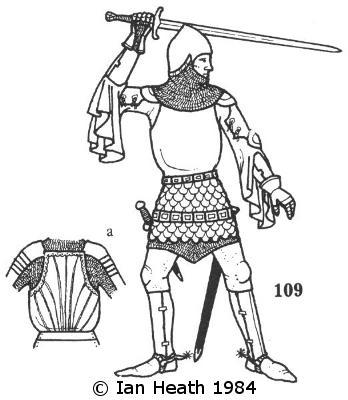Create an Amazon Wedding Registry

Create an Amazon Business Account
GERMAN KNIGHT, KUNZ VON HABERKORN d.1421
An extract from Armies of the Middle Ages, Volume 2
by Ian Heath

[Based on the Tomb effigy of Kunz von Haberkorn in the church of the Knights of St John in Würzburg, Bavaria, Germany, c.1420AD.]
109. GERMAN KNIGHT, KUNZ VON HABERKORN d.1421
From a tomb effigy in the church of the Knights of St John in Würzburg, Bavaria,
this figure bears witness to one of the trends in German armour that was to prevail throughout the 1420s and 1430s, which was the incorporation into the armour of long sleeves,
later dagged. Adopted under the influence of civilian fashion, these would appear to have been part of a tunic worn either over or under the arming doublet or haubergeon,
but invariably under the breastplate. The scale skirt is unusual outside of Bohemia,
but the fact that it was popular in the latter country at about this date is confirmed by the early-15th century Krumlov ms.,
in which many foot-soldiers and men-at-arms alike are shown wearing such skirts,
which the ms. clearly shows to have been quite separate from the breastplate or any sort of corselet, being worn on its own by some figures.
His leg-armour clearly includes plate greaves, while seemingly poleyns and perhaps plate cuisses too are concealed beneath the fabric or leather breeches (?)
that come down to just below the knee. The breastplate would probably be accompanied by a backplate by this late date, buckled at the sides until the mid-15th century
(when a waist-belt often seems to have instead done the job of holding the plates together), and strapped across the shoulders.
This slightly 'boxed' shape of breastplate, sometimes fluted as in 109a, was the most popular form of plate body-armour in Germany from the 1380s until the 1420s.
See a reproduction from the Krumlov Codex depicting Bohemian warriors wearing a scale skirt
Next: 110. GERMAN KNIGHT c.1440 in Armies of the Middle Ages, Volume 2 by Ian Heath


